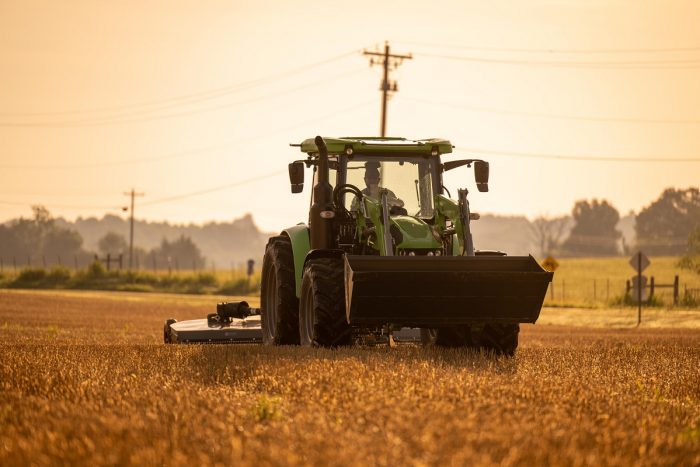Tractor Sales 2025: September Brings Relief but October Data Confirms Ongoing Slump

North American tractor sales finally showed signs of life this fall after a year dominated by declining demand. According to the Association of Equipment Manufacturers (AEM), U.S. tractor sales increased 4.1 percent in September 2025, with 2WD tractor sales rising 5.1 percent. Canada posted an even stronger September, with tractor sales climbing 7.2 percent and combine sales jumping 42 percent. These gains arrived after months of steady declines that pulled the market well below 2024 levels. Here’s what AEM had to say about September:
“After challenging months of continued sales declines in the U.S. market, this modest increase is certainly encouraging,” said Curt Blades, Senior Vice President at the Association of Equipment Manufacturers. “Although there is some uncertainty and volatility in the marketplace, we are optimistic this positive trend will continue, particularly as the harvest season progresses. This improvement in both the U.S. and Canadian market is a testament to the resilience of our industry and the ongoing demand for agricultural equipment.”
However, AEM’s October 2025 tractor report paints a more complex picture. The October data shows the U.S. tractor market still running behind last year across nearly every horsepower class. That contrast matters. September delivered a much-needed rise, but October numbers reveal a sector that remains far from recovery.
U.S. Tractor Sales Still Trail Last Year in October

The October U.S. data shows broad year-over-year declines. Two-wheel drive compact tractors under 40 hp fell 22 percent compared to October 2024. Utility tractors between 40 and 100 hp dropped nearly 11 percent. Higher-horsepower machines, which typically signal major farm investment, saw even sharper declines. Two-wheel drive tractors over 100 hp fell 17.3 percent and four-wheel drive units collapsed 56.3 percent. Even self-propelled combine sales remained down, falling 26.8 percent for the month.
The year-to-date totals through October tell the same story. Compact tractors sit 7.8 percent below 2024 levels. Utility tractors are down 3.8 percent. Higher-horsepower tractors are down nearly 24 percent. Combines remain the weakest category, trailing last year by 38.4 percent. Total U.S. farm tractor sales through October remain 9.2 percent below 2024. This disconnect between September’s rise and October’s deep declines shows how fragile the market remains. A single positive month cannot reverse a year marked by weak farm economics, expensive borrowing and volatile commodity prices.
Canada’s Tractor Market Holds Steadier into Fall

Canada’s October 2025 numbers show a split market rather than a downturn. Compact tractors under 40 hp fell 13.3 percent compared to October 2024, and higher-horsepower tractors declined 19.2 percent. Yet the key mid-range 40–100 hp tractors increased 4.9 percent for the month. Year-to-date totals show Canada nearly flat with 2024. Compact tractors are up slightly for the year, utility tractors are up 4.9 percent and combines sit 1 percent ahead of last year. The overall Canadian market is still down for October, but not by much. Total tractor sales fell 11.6 percent year over year. The year-to-date total for all tractor classes sits only 0.1 percent behind 2024. Compared with the sustained drops in U.S. tractor and combine sales throughout the year, Canada continues to hold a more stable footing.
Farm Economics Explain the Weakness

The farm economy throughout 2025 has been defined by strain. Many farmers now face tariffs that restrict access to critical export markets. They remain caught in a multiyear trade war that limits soybean sales and pushes buyers to Brazil. They see higher costs for fertilizer, seed, land and equipment. They pay more to borrow money. They also navigate more unpredictable weather driven by climate change. Others struggle to secure enough labor due to immigration enforcement. Sentiment surveys echo these issues. A new survey recently released by the National Corn Growers Association (NCGA) said most corn growers surveyed in late summer said they believe the U.S. is in or near a farm crisis. According to the press release:
In what could be a troubling sign for the larger economy, those surveyed indicated that the top changes they were considering making next year would be holding off on equipment purchases, reducing fertilizer applications and looking for options to increase off-farm income.
The prolonged government shutdown in early fall also delayed federal payments and slowed access to farm loans, adding more uncertainty. Under these conditions, large tractor and combine purchases often become the first budget decisions postponed.
What the Fall Numbers Mean for Compact Equipment Buyers

For Compact Equipment’s audience, the fall data reinforces several trends. Compact and utility tractors remain the most active part of the market even during a tough year. Contractors and property owners continue to add or replace machines, though with caution. Dealers in the U.S. may continue to offer incentives to move 2025 inventory, given the year-to-date declines. In Canada, steadier demand may keep mid-range tractors tighter on supply. The September rise shows that demand still exists when conditions allow, but the October declines show how quickly buyers can retreat when uncertainty grows. The compact and utility classes, however, continue to act as the stabilizing force in the wider tractor market.
Keith Gribbins is publisher of Compact Equipment.
Clear snow like a pro with these compact utility tractor tips.




